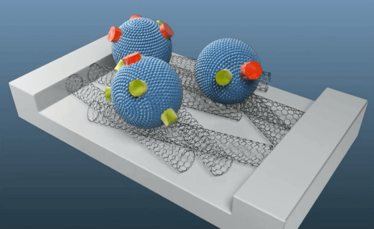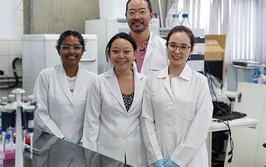A Nose for Quality
Sniffing out ‘off smells’ in drinking water with a bioelectronic sensor

It’s clear that researchers Seunghun Hong, Hwi Jin Ko, and Tai Hyun Park, and the team at Seoul National University, South Korea, all have a nose for sensing; they have already developed several human nose-like biosensors for different applications, such as disease diagnosis and food quality assessment. Park explains why drinking water was next on the agenda: “Recently, a severe green algal bloom has wreaked havoc on the water supply in Korea. So we started to develop a bioelectronic nose for monitoring the quality of drinking water.”
Even the purest of water contains compounds that contribute to its smell or flavor – and the human nose is extremely sensitive to two small, odorous molecules that often slip through the water treatment process. “The bioelectronic sensor was able to selectively detect geosmin and 2-methylisoborneol in drinking water down to 10 ppt,” says Park. “Although these compounds are completely safe at this concentration, the result is an earthy, musty-smelling water, which is off-putting to drink – so the challenge was to find the human olfactory receptors that bind specifically to geosmin and 2-methylisoborneol,” Park added.
Current methods, such as GC-MS, are labor-intensive and time-consuming, but the bioelectronic nose can analyze water samples in real-time. “This makes the sensor suitable to real applications through integration into a portable device that we are currently developing,” says Park.
Hong, Ko, Park and the team of researchers first screened a number of human olfactory receptors to find out which ones bind the odor-causing molecules. Once identified, a single-walled carbon nanotube field-effect transistor was functionalized with olfactory nanovesicles. The human olfactory receptors afford the bioelectronic nose higher selectivity compared with any other sensing material, which allows it to detect odor molecules in various water samples without any pre-treatment process.
But the approach is not without its limitations, as Park explains: “Unfortunately, because nanovesicles are biological materials, they do have a shelf-life – we are currently developing more stable and reusable alternatives to nanovesicles, such as olfactory receptor proteins, nanodiscs containing olfactory receptor proteins and peptides, and so on.”
The researchers also have plans to take their nose into the digital world: “Our next step is to integrate the bioelectronic nose with a smartphone application by applying multi-channel sensing and wireless transport technologies,” adds Park.
- M Son et al., “Real-time monitoring of geosmin and 2-methylisoborneol, representative odor compounds in water pollution using bioelectronic nose with human-like performance”, Biosensors and Bioelectronics, 74, 199–206 (2015).

















